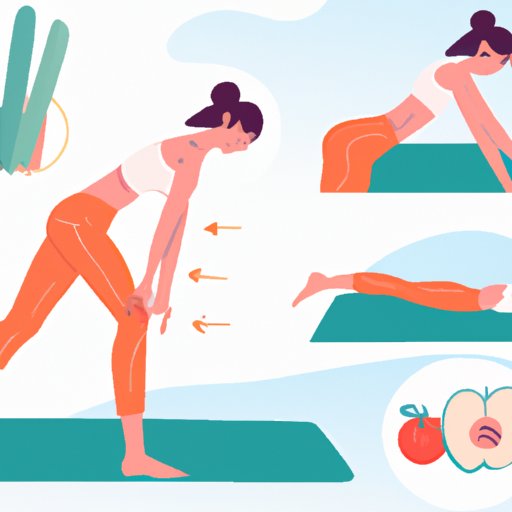Introduction
Lower back pain is a common ailment that affects millions of people worldwide. According to the World Health Organization (WHO), back pain is one of the leading causes of disability worldwide, affecting people of all ages and backgrounds. Fortunately, there are things you can do to help alleviate lower back pain. This article will explore several techniques for reducing lower back discomfort, including strengthening exercises, posture improvement, stretching routines, mindfulness techniques, and diet and nutrition.
Strengthening Exercises
Strengthening exercises are an excellent way to help reduce lower back pain. Stronger muscles can help support the lower back, reducing the risk of strain and injury. One effective exercise is the bridge. To do this exercise, lie on your back with your knees bent and feet flat on the floor. Slowly lift your hips off the ground until your body forms a straight line from your shoulders to your knees. Hold this position for a few seconds and then lower your hips back to the ground. Another useful exercise is the pelvic tilt. Lie on your back with your knees bent and feet flat on the floor. Tighten your lower abdominal muscles and press your lower back into the floor. Hold this position for five seconds and then release.
If you’re new to exercise or have a history of back problems, start with just a few repetitions of each exercise and gradually increase the intensity over time. Aim to perform each exercise two to three times a week.
Improving Posture
Poor posture can contribute to lower back pain, so taking steps to improve your posture can help alleviate discomfort. One simple way to improve your posture is to use a lumbar support pillow. These pillows provide extra support to the lower back, helping to maintain proper alignment. Adjusting the height of your chairs and tables can also help. Ideally, your feet should be flat on the floor, and your elbows should be at a 90-degree angle when using your computer. Finally, consider using a standing desk, which can help prevent prolonged sitting in one position.
Improving your posture can also help prevent future pain. When you sit or stand with good posture, your muscles and joints are in the correct position, reducing the risk of strain and injury.
Stretching Routines
Stretching can be an effective way to alleviate lower back pain by reducing tightness and improving flexibility in the muscles surrounding the lower back. One useful stretch is the hamstring stretch. Lie on your back with one leg extended on the floor and the other leg bent. Hold the back of your thigh and gently pull your leg towards your chest. Hold for 30 seconds and then switch legs. Another effective stretch is the glute stretch. Sit on the floor with your legs extended in front of you. Cross your right ankle over your left knee and gently pull your left knee towards your chest. Hold for 30 seconds and then switch legs.
Making stretching a regular part of your daily routine can help alleviate lower back pain. Try to stretch at least once a day, holding each stretch for 30 seconds to a minute.
Mindfulness Techniques
Mindfulness techniques like meditation and breathing exercises can be effective for pain relief and stress reduction. Meditation can help reduce stress hormones in the body, which can contribute to lower back pain. To incorporate mindfulness techniques into your daily routine, try taking deep breaths throughout the day. When you feel stressed or tense, take a few deep breaths, inhaling through your nose and exhaling through your mouth.
Regular mindfulness practice can help alleviate stress and promote relaxation, which can help reduce lower back pain.
Diet and Nutrition
Diet and nutrition can also play a role in reducing inflammation and improving joint health. Omega-3 fatty acids, found in foods like salmon and walnuts, can help reduce inflammation in the body. A healthy diet and regular exercise can also help with weight management, reducing the strain on the lower back muscles.
Conclusion
Lower back pain is a common ailment, but there are things you can do to help alleviate discomfort. Strengthening exercises, posture improvement, stretching routines, mindfulness techniques, and diet and nutrition can all play a role in reducing lower back pain. Try incorporating some of these techniques into your daily routine to help prevent and reduce lower back pain.
Remember, if you experience persistent or severe back pain, it’s important to consult with a healthcare professional.
